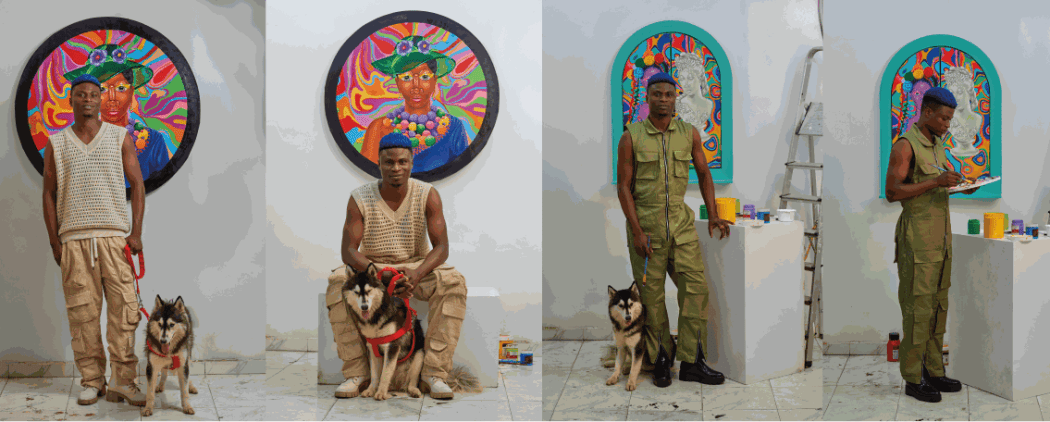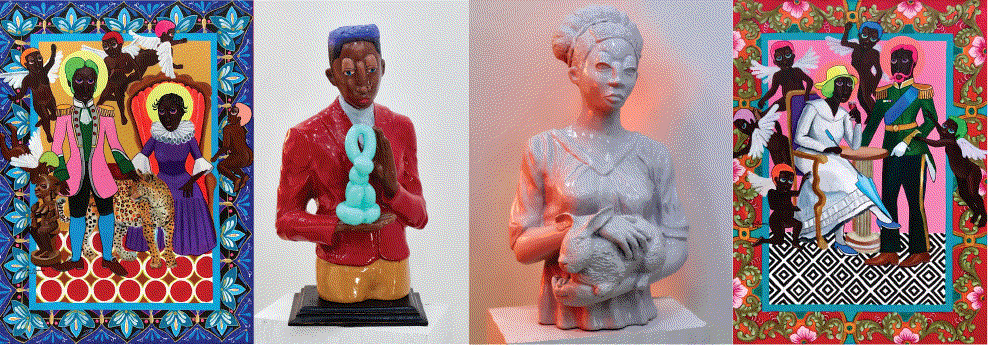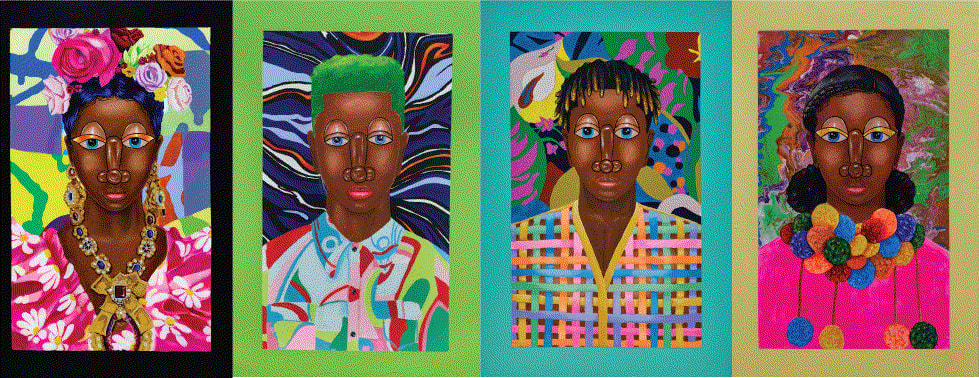
Bakare’s art is deeply inspired by his father, an architect in the city of Lagos who was responsible of encouraging his son since a young age to pursue his creative journey.
After training under the tutelage of prominent and veteran Nigerian artists such as Abiodun Olaku, Raji Babatunde, Edosa Oguigo, and Ejoh Wallace, Bakare developed his own artistic research and signature style which centers around the propagation of black identity and values in both contemporary and retrospective contexts while representing historical scenes.

His narrative covers portraits of African men and women with blank expressions as they strive for cultural emancipation. Samson states that his work is “a time machine through which you can see the past and behold the future from the same standpoint.”
The East African Coptic art has been the influence in his exploration, even as the theme and subject remains a hybrid of classicism and stylization, which he calls Afro-classicism. In his artistic output, Samson has depicted several satirical portrait pieces attempting to review the excesses of British-imperialism and racial equality.
Through his career Bakare has done several collaborations as an exciting one with Gucci in 2022. Samson was chosen by Alessandro Michele together with some other artists to represent the iconic Gucci Bamboo 1947 bag with his remarkable style distinguished by bright colors interpreting his personal vision of the bag in an exquisite bourgeois boho setting.

Dorothy Circus Gallery, London, is proud to present the highly anticipated solo exhibition of Nigerian artist, painter, and sculptor Samson Bakare, which will open to the public, with the artist present, on March 9, 2023.
"Let this be a Sign" consists of a body of 15 brand-new works, including paintings, sculptures, and (pictorial) installations, with a surprising and evocative visual impact.
In the foreground is the theme of unity and harmony, which the artist represents through an exploration of the relationship between art and both physical and temporal space. Bakaredescribes his art as a “time machine” and, in a profound reference to metaphysics, invites the viewer to go beyond the sensations suggested by what one sees.

Bakare's works capture both gaze and thought on a psychedelic canvas, placing us in front of captivating plastic illusions and letting us venture into a game of representation that is both figurative and abstract, in which we lose track of place and time.
We are accompanied in a transversal reading of time by the artist's empathetic googly eyes. Starting from Bakare's cultural roots, but with an eye to the future, we find ourselves authors with him of a new writing of the Black Cultural Figuration, in a leap of intuition and innovation for a story of art and the depth of the human mind that is recurring and cyclical.
Unity is the core concept, brought to light by Bakare as a result of the feeling of recognition aroused by sharing the matrix that unites us all—the memory of our past, our history—as a starting point for the future and for change.

With a distinctive use of a flamboyant, floral-inspired palette, the artist assigns colour a leading role in his investigation of harmony.
In search of the perfect balance between collectivism and individualism, fundamental, according to Bakare, to promoting an inclusive community, the rich compositions, characterized by a vibrant mix of shades, compose before our eyes in kaleidoscopic patterns that embed and mix with the human figure.
Bakare takes us on an investigation into the psychological effects of color, in opposition to the traditional stereotypes associated with its use and enjoyment according to gender, in a reference to the laws of potential differences and challenging the status quo, with this audacious chromatic game.

"Let This Be a Sign" marks a significant moment in the global art market as it recognizes the great potential of contemporary African art. Bakare's unique and profound style, linked to a message of equality and freedom, resonates with pride both among major institutions and private collectors.
Represented in a regal posture, Bakare's portraits embody the statement of our century, which rediscovers social dignity by restoring its position in the future to the black population it deserves.
The Cultural Revolution in "Black Arts" initiated by Jean-Hubert Martin, a pioneer in 1989, with “Magiciens de la Terre” an exhibition held at the Center Pompidou, has been further fueled over the past decade, by significant events such as the 2007 Venice Biennale, the opening of the Zeitz Museum in South Africa in 2017, the Frieze “focus” on African art and art fair in 2013, contemporary African art 1–54 in London in 2013, and the Louis Vuitton Foundation exhibition in 2017.

Institutions such as the Tate Modern in London, the Museum of Modern Art in New York, and other similar institutions have included contemporary African Art in their collections and private collectors are becoming increasingly interested in contemporary African art, especially the work of young African artists who are at the center of a lively and constantly evolving Art scene which is opening up the possibility for a new wave of new significant African contemporary art collections.
“I am aware that the African art scene is relatively new compared to other parts of the world, so I want to take the opportunity to showcase African art and culture to the rest of the world in order to break down the stereotype and culture shock that people can have when they see African art. "I want to make African art as familiar to people as any other art form, so that it becomes “us” and not just “us Africans.” "




